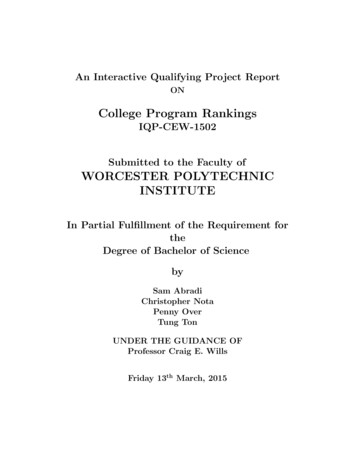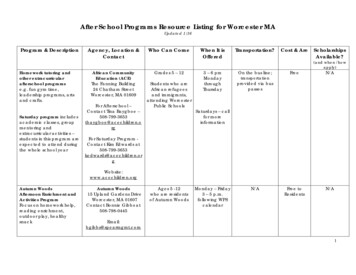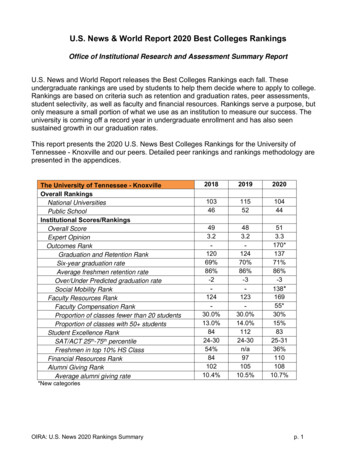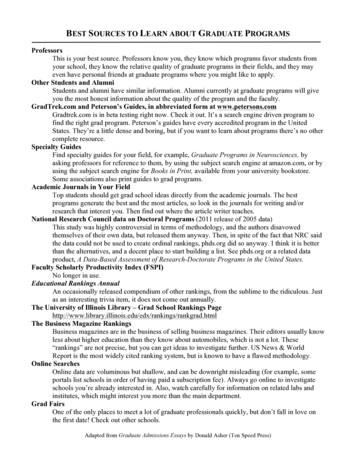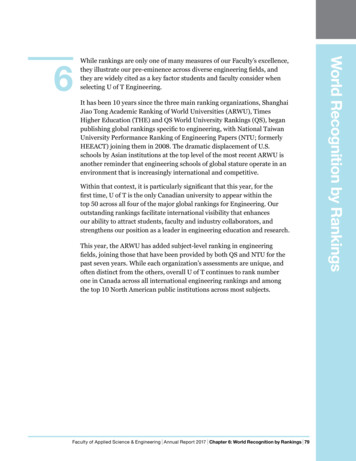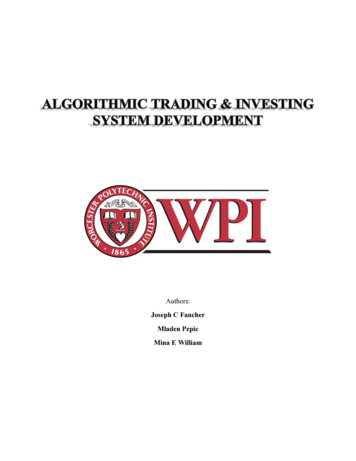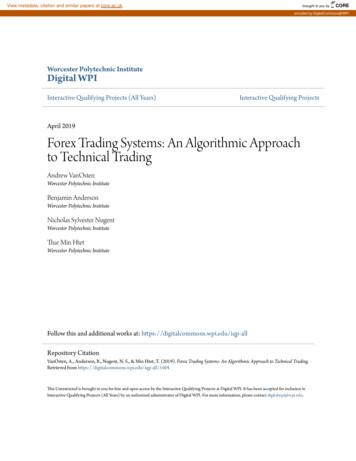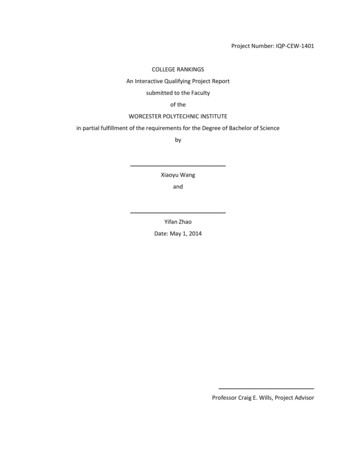
Transcription
Project Number: IQP-CEW-1401COLLEGE RANKINGSAn Interactive Qualifying Project Reportsubmitted to the Facultyof theWORCESTER POLYTECHNIC INSTITUTEin partial fulfillment of the requirements for the Degree of Bachelor of SciencebyXiaoyu WangandYifan ZhaoDate: May 1, 2014Professor Craig E. Wills, Project Advisor
AbstractMany college rankings exist, each based on a set of factors determined by publishers of therankings. People considering colleges often use college rankings as a tool to aid them in their search.This project compares the methodology of rankings by organizing the factors of each into six categories.It was found that worldwide rankings have a much higher weighting on research than U.S.-only rankings.In addition a survey was conducted over different demographic groups. From the survey results an idealranking was constructed for different groups and compared to existing rankings. All demographic groupsexamined seek a better mix of categorized factors than any existing ranking provides.ii
Table of ContentsAbstract . ii1. Introduction . 51.1 Road Map . 72. Background . 82.1 Impact of College Rankings . 82.2 Data Sources used by College Rankings . 82.3 College Resources . 102.4 Summary . 113. Approach . 123.1 Justification of the Rankings Selected. 123.2 Classification of Factors into Categories . 133.2.1 Initial Categories: Input, Output, University . 133.2.2 Division of University Category . 143.2.3 Creation of the Research Category . 143.2.4 Removal of Faculty Category . 143.2.5 Final Categories . 153.3 Subjective vs. Objective Factors. 163.4 Summary . 164. Ranking Results . 174.1 Analysis of Factors in Rankings against the Combination of Categories and Subjective versusObjective Measures . 174.1.1 Category 1: Student Body . 174.1.2 Category 2: Research . 174.1.3 Category 3: Academics . 194.1.4 Category 4: Student Life . 214.1.5 Category 5: Finance . 214.1.6 Category 6: Post-Graduation Success . 224.2 Summary of Ranking Results. 234.2.1 Distribution of Six Categories in U.S.-only College Rankings . 234.2.2 Distribution of Six Categories in World College Rankings . 244.2.3 Distribution of Subjective versus Objective Factors in U.S.-only College Rankings . 254.2.4 Distribution of Subjective versus Objective Factors in World College Rankings . 26iii
4.3 Summary . 275. Survey. 295.1 Motivation for Producing a Survey . 295.2 Survey Design . 295.3 Summary of Survey Responses . 305.4 Summary . 386. Analysis of Survey Results . 396.1 Comparison of Responses between United States and non-United States Residents. 396.1.1 Importance of Six Categories . 406.1.2 Importance of Subjective versus Objective Factors . 416.2 Comparison of Responses between Respondents below 26 and above 35 . 416.2.1 Importance of Six Categories . 416.2.2 Importance of Subjective versus Objective Factors . 426.3 Comparison of Responses between Male and Female Respondents . 426.3.1 Importance of Six Categories . 436.3.2 Importance of Subjective versus Objective Factors . 436.4 Comparison of Responses between Current Students and Parents . 446.4.1 Importance of the Six Categories . 446.4.2 Importance of Subjective versus Objective Factors . 456.5 Comparison of Responses between Future Students and Parents. 456.5.1 Importance of Six Categories . 466.5.2 Importance of Subjective versus Objective Factors . 476.6 Summary . 477. Comparing Ranking and Survey Results . 487.1 Comparisons for U.S.-only Rankings . 487.2 Comparisons for World Rankings. 497.3 Summary . 508. Conclusion . 518.1 Summary . 518.2 Future Work . 52Works Cited . 53Appendix . 57iv
1. IntroductionPresident Obama has recently announced an initiative to grade colleges based on theirperformance [1] in terms of financial cost and expected return. The idea behind this initiative is to holdcolleges accountable for the financial costs they incur on students. The College Board reported for the2013-2014 school year that the average tuition for students attending in-state four-year schools was 8,893, out-of-state schools 22,203, and private schools 30,094 [2]. With such a high financial cost, itis imperative that students choose the best college available to them at a reasonable financial cost.There are many resources available to assist students in this endeavor. In addition to PresidentObama’s initiative to grade colleges based on their performance, there are college rankings released byorganizations such as Forbes [3] and U.S. News and World Report [4] consider various factors whengenerating a ranking of colleges. Each ranking assigns different weights to various factors. Depending onwhich factors they consider and how important each factor is to a college’s score, the rankings can differsignificantly.Consider for example, two rankings previously mentioned, Forbes and US News and WorldReport. Not only do their rankings differ, they also have different criteria for including or excludingschools from their rankings. US News and World Report generates two separate rankings, one for whatthey call National Universities [5] and another for what they call National Liberal Arts Colleges [6] whileForbes generates a single ranking [7] for all colleges in the United States. Naturally, one would expectthe rankings to be significantly different. However, if only the institutions presented in the Forbesrankings that are present in the U.S. News and World Report National University Rankings areconsidered, discrepancies between their relative rankings with respect to each other would be present.Forbes has Stanford University as the top school, followed by Princeton University, Yale University,Columbia University, and Harvard University. The National University Rankings by U.S. News and WorldReport has Princeton University as the top institution, followed by Harvard University, Yale University,Columbia University, and Stanford University. This is only comparing the top five schools in the ForbesTop Colleges List that are also present in the National University Rankings generated by U.S. News andWorld Report.Upon examination of multiple rankings, commonalities between the rankings can bedocumented. The factors under consideration tend to group into six broad categories. These sixcategories can be defined as Student Body, Research, Academics, Student Life, Finances, and PostGraduation Success. The Student Body category is a grouping of factors measuring aspects of the5
general student body at a college or university. For the Research category all factors measuring theresearch output of the university and faculty research are included. Factors measuring faculty teachingand salary were excluded from Research and placed in the Academics category instead. In theAcademics category all factors relating to the quality of education received are included. For StudentLife those factors relating to daily quality of life at the college or university are considered. In theFinance category only factors relating to the financial status of the student are considered. Factors suchas tuition and average financial aid package are considered to be part of this category. However, factorssuch as the endowment of the school are not considered to be part of this category. For PostGraduation success factors that measure the success of graduates from the school are included.In addition to college rankings, college guidebooks like the Princeton Review [8], and othercollege resources such as College Confidential [9] and College Prowler [10] are also looked at. While theguidebooks do not contain an explicit ranking, some do rate schools based on a variety of factors.Although they are not rankings, they are still useful since the factors that the guidebooks consider canbe compared to those of the rankings. The website called College Prowler permits the user to generatetheir own importance for each factor, then create a customized ranking based on those factors. TheCollege Prowler ranking is not considered an actual ranking to be analyzed since the rankings will differfrom user to user.This project hopes to discover which of the college rankings is most relevant to people looking atcolleges. To begin, different college rankings including both U.S.-only and worldwide rankings weresearched for through popular search engines. Then, through reading the methodologies, we comparedthe factors each ranking considers, and categorized those factors into six broad categories. Furthermore,we calculated the proportion of the six categories for each ranking to have a more direct perspective ofwhat each ranking concentrates on. At the same time, we also looked at the subjective and objectiveproportions in each ranking. We regarded the proportion of subjective versus objective factors inranking to be important since subjective factors are based on people’s opinions whereas objectivefactors are grounded in hard data. That is not to say that objective factors cannot be biased. Themethodology behind interpreting data can affect the results significantly.When analyzing the different ranking methodologies, it is important to keep in mind the scopeof the ranking itself. In our analysis we looked at both U.S.-only rankings such as U.S. News and WorldReport and world rankings such as Times Higher Education [11]. After analyzing our rankings, we foundthat the world university rankings tended to consist of different criteria in different proportions than theU.S.-only rankings.6
1.1 Road MapThe goal of this report is to look at the most commonly referenced rankings and determine themethodology that they use to rank colleges and universities and determine how they are similar anddifferent. In order to better understand what most people value more when considering colleges, wesent out a survey on which rankings people are more familiar with, which categories people value more,and their demographic information. The survey was used to determine what categories mattered themost to people so that and “ideal ranking” of colleges and universities could be recommended to them.In this report, the basic foundations behind college rankings are first discussed. In the chapterimmediately following, a discussion on the impact of college rankings is presented. The data sourcesused by the college rankings are discussed, as well as a brief comment on other resources to aid collegeseekers aside from rankings.In Chapter 3 a discussion of the approach in selecting college rankings to analyze is discussed.Also included is a discussion of the formulation of the six categories used in grouping together factors.Chapter 4 includes a discussion on the factors that rankings use to determine how to place colleges anduniversities within their rankings and in which categories the factors fall within. How much each rankingconsiders each of their six categories in their ranking and the proportion of subjective versus objectivefactors considered by the rankings is discussed as well.Chapter 5 opens with the discussion of the survey distributed to determine people’s opinions oncollege rankings and the categories of factors that are important to them in considering colleges. Theresults of the survey are presented. Comments on the overall scores for the importance of the sixcategories are discussed, as well as any additional comments made by respondents.Chapter 6 makes comparisons between different demographic groups recorded in the survey. Aseries of statistical analyses is performed to determine if there are any statistically significant differencesin how different groups of respondent rated the importance of each of the six categories. Chapter 7further expands on the idea of the six categories and compares the weighted score for the six categoriesagainst the weights of each of the six categories presented in the rankings. Weighed score in contextmeans the score of the category divided by the sum of scores for all six categories. Chapter 8 concludesthe report with a recommendation for the “ideal ranking” for the population surveyed, as well as adiscussion on the pros and cons of college rankings. A discussion on future work is presented in Chapter8 as well.7
2. BackgroundCollege and university rankings are enumerated lists of colleges and universities based on theirperformance in a variety of fields. Certain rankings are more specialized than other rankings. Forexample PayScale includes only financial factors [12] in their ranking of colleges. Other rankings such asU.S. News and World Report [4] and Forbes [3] consider a larger variety of factors.2.1 Impact of College RankingsIt is undeniable that college rankings have had an impact on the colleges and universities theyrank. However, some universities are taking rankings perhaps far too seriously, taking measures toensure that they stay high ranked. Andrejs Rauhvargers in his report Global University Rankings andTheir Impact II [13] gives some examples of actions that universities have taken to manipulate theirscore on rankings. He states that many universities encourage students that have no hope of beingaccepted to apply in order to increase the appearance of selectivity. Rauhvargers also documentsinstances of universities encouraging faculty to take academic leave in the spring instead of autumn,since U.S. News and World Report determines full time faculty for student/staff ratio in autumn.Rauhvargers also outlines the deficiencies of rankings. He concludes that rankings fail theirprimary purpose of making universities more transparent, as it is difficult to follow the calculationsmade by the rankings to reach the final result using only publically available information. He alsoaddresses the fact that the rankings thus far only cover some university missions, and not all of them.The rankings that currently exist at the international level focus predominantly on the research aspectsof universities, in particular that of the hard sciences.2.2 Data Sources used by College RankingsThe rankings produces their results by analyzing a pool of data collected from assorted datasources. Examples of data sources are described in the following.Center for Measuring University PerformanceThe Center for Measuring University Performance [14] is a research group focused on compilingdata about research expenditures of university. The CMUP also provides data on members of NationalAcademies, significant faculty awards, doctorates awarded, postdoctoral appointments, median SATscores, endowments, and annual giving [15].8
Common Data SetThe Common Data Set (CDS) [16] is a collaborative effort among data providers and publishersin the higher education community to provide an accurate and high quality source of information to allinvolved in a student’s transition into higher education. The CDS is created by a collaborative effort fromthe College Board, Peterson’s, and U.S. News and World Report. Data items and definitions used by theU.S. Department of Education in its higher education surveys serve as a guide for the items included inthe CDS. Data is collected by sending out surveys to target institutions. Information from the CDS is usedby U.S. News and World Report [4] in order to generate its rankings. Items in the CDS undergo review bythe CDS Advisory Board.Integrated Postsecondary Education Data SystemThe Integrated Postsecondary Education Data System (IPEDS) is a group of surveys conductedannually by the U.S. Department of Education’s National Center for Education Statistics (NCES) [17].IPEDS gathers information from every college, university, and technical and vocational programs thatparticipate in federal student aid programs. For these institutions participation in the IPEDS survey ismandatory. IPEDS provides data on number of students enrolled, staff employed, dollars expended, anddegrees earned [17].Peterson’sPeterson’s [18] is a set of data collected from surveys sent to accredited colleges anduniversities. Peterson’s also contacts college to verify unusual data and resolve discrepancies if theyexist.SCImago GroupSCImago Group is a group that publishes reports on the research output on universities [19]. Thegoal of the report is so that universities can analyze and then improve their research results. Althoughinstitutions are ordered by score, they are not explicitly ranked. Thus it was not considered to be aranking but rather part of a data set used to generate a ranking.9
ScopusScopus [20] is an abstract and citation database of peer-reviewed research. As a data source it isused to find the amount of citations that papers published by an institution have. Scopus is used by theCWTS Leiden Ranking to provide the number of citations [21].Thomson Reuters Global Profiles ProjectThe Thomson Reuters Global Profiles [22] project is a set of surveys developed to produce a datasource that provides an effective resource to build profiles of universities around the world. The GlobalProfiles Project only contains what Thomson Reuters considers to be globally significant institutions. TheGlobal Profiles Project combines together factors of reputational assessment, scholarly output, fundinglevels, faculty characters, and more in a single database. This data set is used by Times Higher Educationto publish what they claim to be “the most definite set of World University Rankings so far.”2.3 College ResourcesIn addition to college rankings, there are also other college resources available to assist studentsand parents during the college search process. An example of what is considered a college resource is awebsite like College Confidential [9]. The website possesses a variety of articles on the college searchand admissions process. In addition users registered on the website can post discussions in the CollegeConfidential forum. The website also has a tool where users can filter colleges using a variety of criteria,such as tuition cost and average SAT score.Another type of college resource is a guidebook. An example of a college guidebook is the FiskeGuide to Colleges [23]. Fiske also offers a variety of other guides to assist college-bound seniors andparents in the college admissions process such as guides on how to write essays and taking the SAT.Another example of a college guidebook is the Princeton Review [8]. Although the guidebook publishedby the Princeton Review includes ranks colleges in various categories, they only list the top 20 schools ineach of the rankings. The rankings are also structured more like a guidebook, with a school’s position inthe ranking followed by a short description of why the school is ranked there, rather than justpresenting the school’s ranking like other college rankings. In short, the Princeton Review possessesmore flavor text than what an actual college ranking would possess.Included under college resources are tools that permit users to construct their own ranking ofcolleges and universities. College Prowler is an example of a website with such a tool [10]. Users ofCollege Prowler can select the importance of a wide variety of factors to them then produce a ranking of10
colleges and universities based on their selection. The factors that users can select include Academics,Athletics, Campus Dining, Campus Housing, Campus Strictness, Computers, Diversity, Drug Safety,Facilities, Girls, Guys, Greek Life, Health and Safety, Local Atmosphere, Nightlife, Off-Campus Dining, OffCampus House, Parking, Transportation, and Weather. Since College Prowler and websites similar to itprovide no actual college rankings without user input, it is considered to be a college resource ratherthan a college ranking.Introduced in February of 2013, the White House College Scorecard is designed by the U.S.Department of Education to provide information to students and parents about the affordability of acollege or university and the relative value it provides for the cost [24]. The information provided by theCollege Scorecard includes undergraduate enrollment, costs, graduation rate, loan default rate, medianborrowing, and employment. The data displayed by the College Scorecard is collected by the U.S.Department of Education.2.4 SummaryIn this chapter, a discussion of previous work studying the effects of college rankings waspresented. A summary of the data sources used by college rankings was discussed, and a brief overviewof various college resources was provided. The college resources were overviewed in a way thatoutlined their usefulness to people considering colleges.11
3. Approach3.1 Justification of the Rankings SelectedCollege rankings are important for students planning to study at a college. Sometimes, a studentmakes his or her choice simply by comparing the candidate colleges in different rankings and readingcomments online. The factors they consider may vary from academic rankings to post-graduation salaryrankings, from campus life to financial aid resources, from faculty resources to reputation, and so on.Accordingly, rankings composed of different factors are designed to help students make their choices.So, among all the rankings, which are more popular? What are some representatives? What are theirmethodologies? Where do they gather data?To answer the above questions, we started with the rankings we used when we chose ourcolleges. Such examples are U.S. News and World Report National University Rankings, Times HigherEducation World University Rankings, College Guide [25] by Washington Monthly, and Academic Rankingof World Universities [26] by Shanghai Jiao Tong University. Then, to enlarge the number of rankings weconsider, we searched online to see what additional rankings we could find.When searching “College Rankings” in Google, the entries come to the top of the page includecollege rankings from U.S. News, America’s Top Colleges List from Forbes [7], College Guide fromWashington Monthly [27], College Rankings from Princeton Review [8], and so on. Most of them areU.S.-only rankings. In the next several pages of search results, most of the rankings are sports rankings,which do not seem as important as the ones in the first page, since the majority of students would notconsider sports as a factor of vital importance.When searching “World Rankings”, websites like Times Higher Education World UniversityRankings, and QS World University Rankings come out. A link from U.S. News comes out first, but this isonly an article about world universities, rather than a ranking.With the help of Professor Wills, other rankings were also looked at. A paper called “GlobalUniversity Rankings and Their Impact Report II” [13] gave more clues. Therefore rankings based onresearch like CWTS [28] and Webometrics [29] were added.Table 1 summarizes all of the rankings considered.12
Table 1: University RankingsPublisherForbesKiplingerPayScaleU.S. NewsWashington MonthlyCWTSQSShanghai Jiao Tong UniversityTimes Higher EducationWebometricsTitleAmerica's Top CollegesKiplinger's Best Values in Private CollegesCollege Education Value RankingsNational University Rankings2013 National University RankingsCWTS Leiden Ranking 2013QS World University Rankings - 2012Academic Ranking of World UniversitiesTHE World University RankingsRanking Web of lyU.S.-onlyWorldWorldWorldWorldWorldOverall, both worldwide and U.S.-only rankings were chosen to be studied. They also havedifferent focuses: some of them focus more on academics and reputation, while others focus more oncampus life and post-graduation success.Other resources such as College Prowler, Department of Education Colle
COLLEGE RANKINGS An Interactive Qualifying Project Report submitted to the Faculty of the WORCESTER POLYTECHNIC INSTITUTE in partial fulfillment of the requirements for the Degree of Bachelor of Science by Xiaoyu Wang and Yifan Zhao Date: May 1, 2014 Professor Craig E. Wills, Project Advisor ii Abstract
